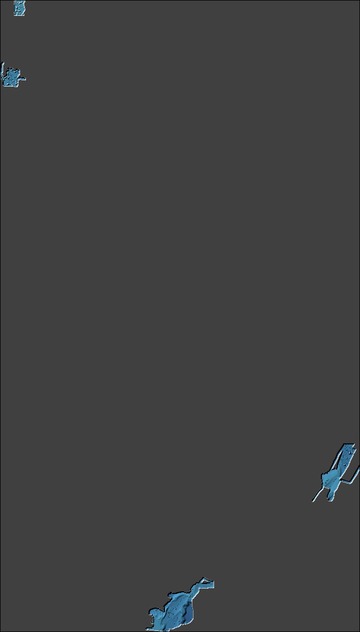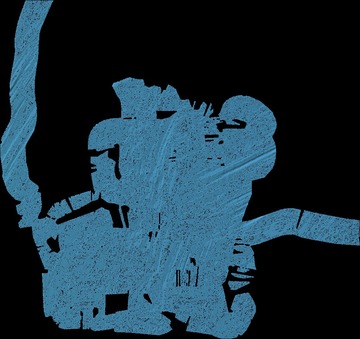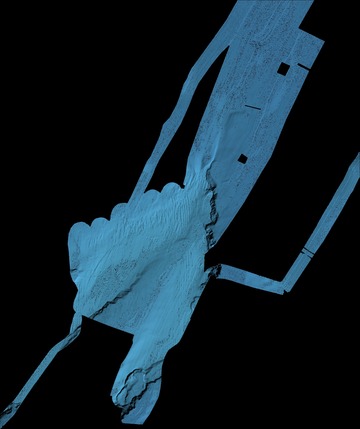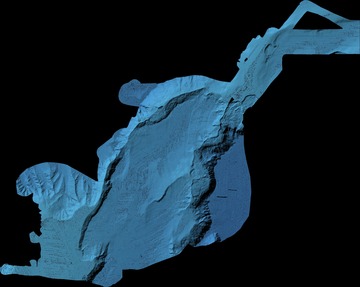Citation
Martin Jakobsson, Larry Mayer, Björn Eriksson, Rezwan Mohammad, Kevin Jerram, Denis Chernykh, Roman Ananyev (2021) High-resolution bathymetry data from expedition SWERUS-C3 Leg 2, Arctic Ocean, 2014. Dataset version 1. Bolin Centre Database. https://doi.org/10.17043/oden-swerus-2014-leg-2-bathymetry-1
References
- Weidner, E., Weber, T. C., Mayer, L., Jakobsson, M., Chernykh, D., and Semiletov, I., 2019, A wideband acoustic method for direct assessment of bubble-mediated methane flux: Continental Shelf Research, v. 173, p. 104-115. https://doi.org/10.1016/j.csr.2018.12.005
- Stranne, C., Mayer, L., Jakobsson, M., Weidner, E., Jerram, K., Weber, T. C., Anderson, L. G., Nilsson, J., Björk, G., and Gårdfeldt, K., 2018, Acoustic mapping of mixed layer depth: Ocean Sci., v. 14, no. 3, p. 503-514. https://doi.org/10.5194/os-14-503-2018
- Björk, G., Jakobsson, M., Assmann, K., Andersson, L. G., Nilsson, J., Stranne, C., and Mayer, L., 2018, Bathymetry and oceanic flow structure at two deep passages crossing the Lomonosov Ridge: Ocean Sci., v. 14, no. 1, p. 1-13. https://doi.org/10.5194/os-14-1-2018
- Stranne, C., Mayer, L., Weber, T. C., Ruddick, B. R., Jakobsson, M., Jerram, K., Weidner, E., Nilsson, J., and Gårdfeldt, K., 2017, Acoustic Mapping of Thermohaline Staircases in the Arctic Ocean: Scientific Reports, v. 7, no. 1, p. 15192.
- Jakobsson, M., Pearce, C., Cronin, T. M., Backman, J., Anderson, L. G., Barrientos, N., Björk, G., Coxall, H., de Boer, A., Mayer, L. A., Mörth, C. M., Nilsson, J., Rattray, J. E., Stranne, C., Semilietov, I., and O'Regan, M., 2017, Post-glacial flooding of the Beringia Land Bridge dated to 11,000 cal yrs BP based on new geophysical and sediment records: Climate of the Past, no 13, p. 1-22. https://doi.org/10.5194/cp-2017-11
- O'Regan, M., Backman, J., Barrientos, N., Cronin, T. M., Gemery, L., Kirchner, N., Mayer, L. A., Nilsson, J., Noormets, R., Pearce, C., Semiletov, I., Stranne, C., and Jakobsson, M., 2017, The De Long Trough: a newly discovered glacial trough on the East Siberian continental margin: Climate of the Past, v. 13, no. 9, p. 1269-1284. https://doi.org/10.5194/cp-13-1269-2017
- Cronin, T. M., O'Regan, M., Pearce, C., Gemery, L., Toomey, M., Semiletov, I., and Jakobsson, M., 2017, Deglacial sea level history of the East Siberian Sea and Chukchi Sea margins: Climate of the Past, v. 13, no. 9, p. 1097-1110. https://doi.org/10.5194/cp-13-1097-2017
- Nilsson, J., Jakobsson, M., Borstad, C., Kirchner, N., Björk, G., Pierrehumbert, R. T., and Stranne, C., 2017, Ice-shelf damming in the glacial Arctic Ocean: dynamical regimes of a basin-covering kilometre thick ice shelf: The Cryosphere, v. 11, no. 4, p. 1745-1765. https://doi.org/10.5194/tc-11-1745-2017
- Anderson, L. G., Björk, G., Holby, O., Jutterström, S., Mörth, C. M., O'Regan, M., Pearce, C., Semiletov, I., Stranne, C., Stöven, T., Tanhua, T., Ulfsbo, A., and Jakobsson, M., 2017, Shelf–Basin interaction along the East Siberian Sea: Ocean Science, v. 13, no. 2, p. 349-363.
- Stranne, C., O'Regan, M., Dickens, G. R., Crill, P., Miller, C., Preto, P., and Jakobsson, M., 2016, Dynamic simulations of potential methane release from East Siberian continental slope sediments: Geochemistry, Geophysics, Geosystems. https://doi.org/10.1002/2015GC006119
- Jakobsson, M., Nilsson, J., Anderson, L., Backman, J., Björk, G., Cronin, T.M., Kirchner, N., Koshurnikov, A., Mayer, L., Noormets, R., O’Regan, M., Stranne, C., Ananiev, R., Macho, N.B., Cherniykh, D., Coxall, H., Eriksson, B., Flodén, T., Gemery, L., Gustafsson, Ö., Jerram, K., Johansson, C., Khortov, A., Mohammad, R. and Semiletov, I., 2016, Evidence for an ice shelf covering the central Arctic Ocean during the penultimate glaciation: Nature Communications, 7, 10365. https://doi.org/10.1038/ncomms10365
- Jakobsson, M., Mayer, L.A., Bringensparr, C., Castro, C.F., Mohammad, R., Johnson, P., Ketter, T., Accettella, D., Amblas, D., An, L., Arndt, J.E., Canals, M., Casamor, J.L., Chauché, N., Coakley, B., Danielson, S., Demarte, M., Dickson, M.-L., Dorschel, B., Dowdeswell, J.A., Dreutter, S., Fremand, A.C., Gallant, D., Hall, J.K., Hehemann, L., Hodnesdal, H., Hong, J., Ivaldi, R., Kane, E., Klaucke, I., Krawczyk, D.W., Kristoffersen, Y., Kuipers, B.R., Millan, R., Masetti, G., Morlighem, M., Noormets, R., Prescott, M.M., Rebesco, M., Rignot, E., Semiletov, I., Tate, A.J., Travaglini, P., Velicogna, I., Weatherall, P., Weinrebe, W., Willis, J.K., Wood, M., Zarayskaya, Y., Zhang, T., Zimmermann, M., Zinglersen, K.B., 2020. The International Bathymetric Chart of the Arctic Ocean Version 4.0. Scientific Data 7, 176. https://doi.org/10.1038/s41597-020-0520-9
Data
Data description
The bathymetric data are provided as processed grids, divided into survey areas, with a grid cell size of 30 m. The grids are provided both in polar stereographic projection (IBCAO Polar Stereographic, EPSG 3996, true scale at 75 degrees north) and unprojected WGS 84 and in geographic coordinates (latitude and longitude). The horizontal datum is WGS 84 and the vertical datum is instantaneous sea level, implying that the vertical level has not been corrected for tides. For each projection, the bathymetric data grids are available in four formats: GeoTiff, netCDF, ASCII XYZ and ESRI Arc ASCII grid. Data are also illustrated as JPEG images.
Comments
The data were acquired in summer through autumn 2014 from Swedish icebreaker (IB) Oden during the SWERUS-C3 expedition. A Kongsberg EM122 1° × 1°, 12 kHz, multibeam echo-sounder was hull-mounted in IB Oden. Position, heading and attitude data were received from a Kongsberg-Seatex Seapath 320 navigation unit (GPS and GLONASS) with attached MRU5 motion sensor. The exact speed of sound at the multibeam transducers was provided by a Valeport Mini SVS/T sound speed and temperature sensor mounted in the sea-chest in Oden’s hull, close to the multibeam transducer arrays. This was interfaced with the multibeam system directly. In addition, sound speed profiles for the entire water column were provided by CTD (Conductivity, Temperature, Depth) stations as well as XBT (Expendable Bathy Thermograph) probes.
The data were collected in a mixture of sea-ice conditions, ranging from 5/10 to 8/10 coverage. Navigation was provided by a Seatex Seapath 320 without local augmentation as this is not available in the area. Sound speed correction was done regularly using data from a Seabird 911+ CTD (conductivity, temperature depth) or Valeport SVP (sound velocity profiler).
The SWERUS-C3 expedition consisted of two 45-day legs. Leg 1 started on 5 July from Tromsø Norway and worked along the Siberian continental shelf towards Barrow, Alaska, where both scientific personnel and crew were replaced. Leg 2 departed from Barrow on 21 August, and this part of the expedition took Oden farther out from the Siberian continental shelf and slope into the deep central Arctic Ocean.
The expedition formed the key component of a research program with core funding from the Knut and Alice Wallenberg Foundation (KAW). The expedition was financed by KAW and the Swedish Polar Research Secretariat. The project was developed into a multi-disciplinary international research program investigating the contemporary and historical functioning of the climate-cryosphere-carbon (C3) system of the East Siberian Arctic Ocean and adjacent deep waters off the continental shelf. Expedition participants were from Sweden, Russia, USA, Norway, Canada, UK, Germany, Belgium and the Netherlands.
Contact information
Email address
[javascript protected email address]Phone number
+46-8-164719
Postal address
Martin Jakobsson
Department of Geological Sciences
Stockholm University
SE-106 91 Stockholm
Sweden
GCMD science keywords
Earth science > Oceans > Bathymetry/seafloor topography > Bathymetry
GCMD location
Ocean > Arctic Ocean
Status
Completed
Dataset language
English
Project
Swedish – Russian – US Arctic Ocean Investigation of Climate-Cryosphere-Carbon Interactions (SWERUS-C3) expedition
Publisher
Bolin Centre Database
Begin date
2014-07-06
End date
2014-10-14
Dataset version
1
DOI
10.17043/oden-swerus-2014-leg-2-bathymetry-1
Published
2021-11-04 15:14:14









